Transforming a basement starts from the ground up. Choosing the right flooring not only battles moisture but also sets the room’s personality, whether you’re planning a cozy den, a sleek gym, or a full-on apartment. Below, you’ll discover 25 basement floor ideas that balance style, durability, and comfort — each one a complete concept ready to inspire your renovation.
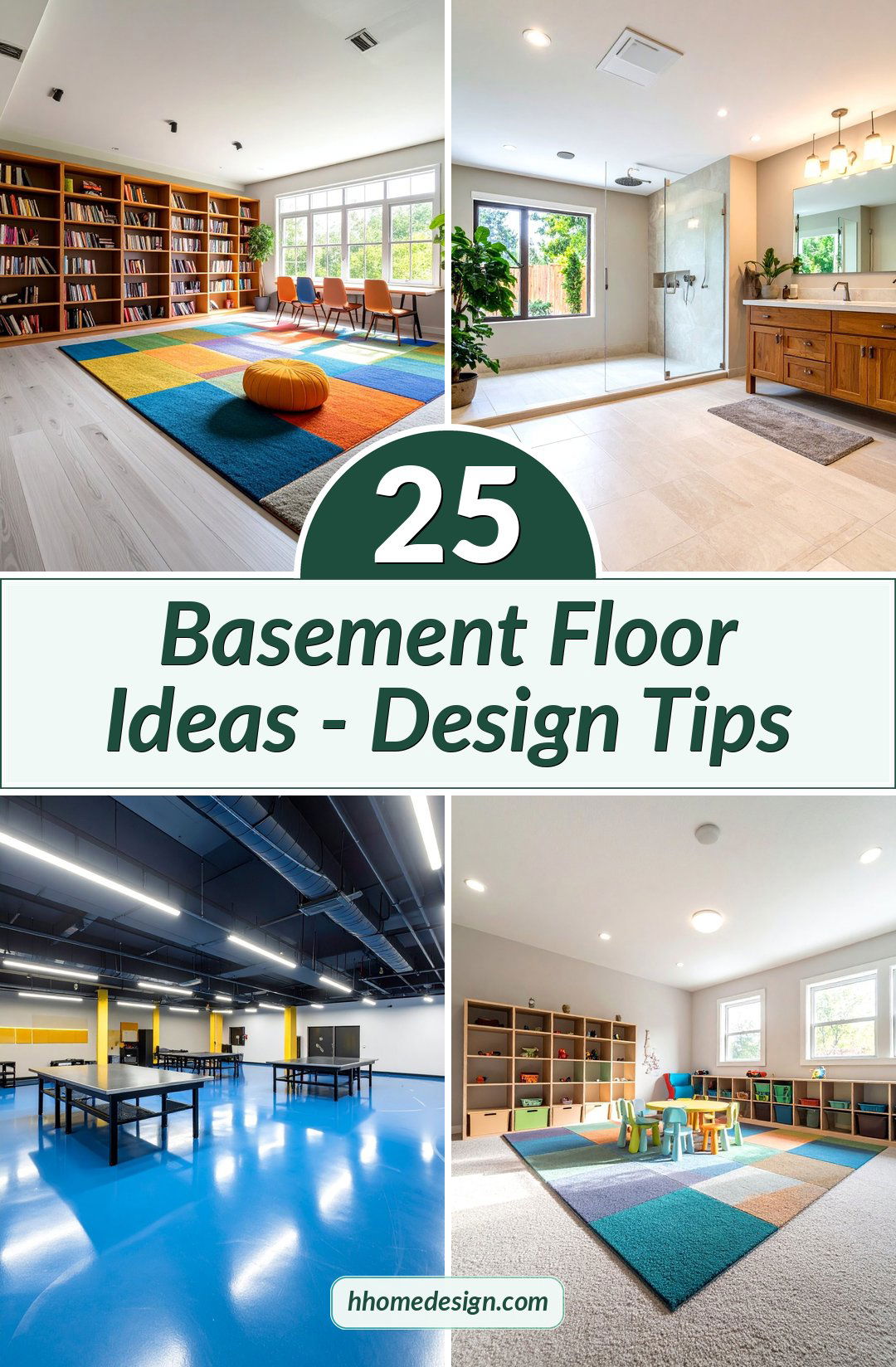
1. Polished Concrete Basement Floor
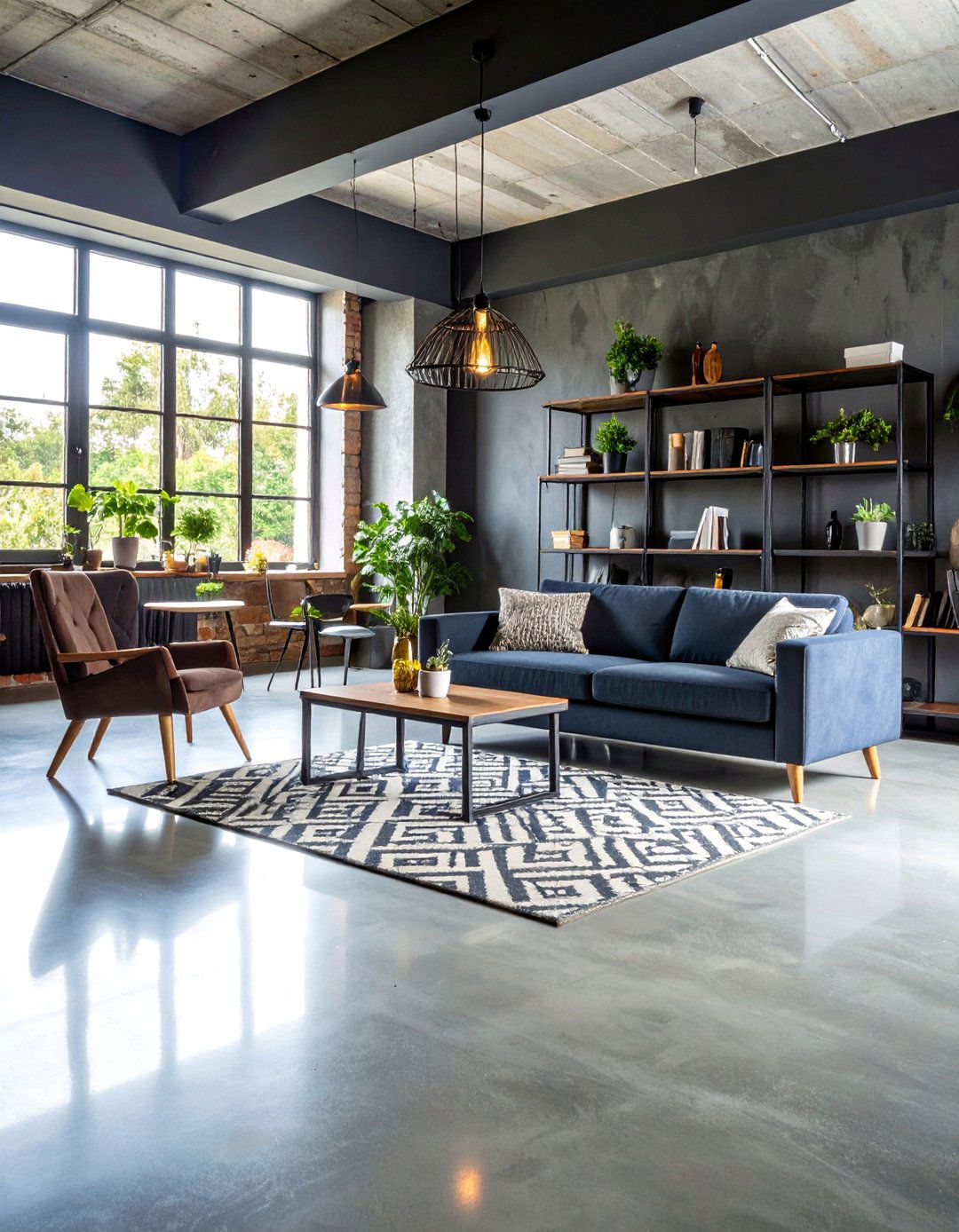
A polished concrete basement floor delivers modern minimalism with unmatched resilience. The slab is ground, honed, and sealed until it gleams like stone, reflecting light to brighten traditionally dim basements. Integrate subtle gray walls, matte-black metal shelving, and track lighting for a loft-style entertainment lounge. Stain the concrete a soft pewter or charcoal for depth, then finish with area rugs in geometric patterns to soften acoustics and add warmth. Because polished concrete resists moisture and scratches, it’s perfect for households with pets or frequent foot traffic. Regular dry mopping and periodic resealing keep the floor glossy for decades.
2. Luxury Vinyl Plank Basement Floor

Looking for wood warmth without wood worries? Luxury vinyl plank (LVP) basement flooring mimics oak, walnut, or even weathered barn boards while shrugging off moisture. Choose wide, hand-scraped planks and pair them with creamy walls, rustic beams, and oversized sectionals for a farmhouse-chic media room. LVP’s click-lock installation floats over a vapor barrier, cushioning footsteps and dampening sound. Built-in wear layers resist scuffs from toys or workout equipment, making it family-friendly. Occasional sweeping and a damp mop keep the surface pristine. Thanks to its budget-friendly price and realistic textures, LVP continues to top remodelers’ recommendation lists.
3. Engineered Hardwood Basement Floor
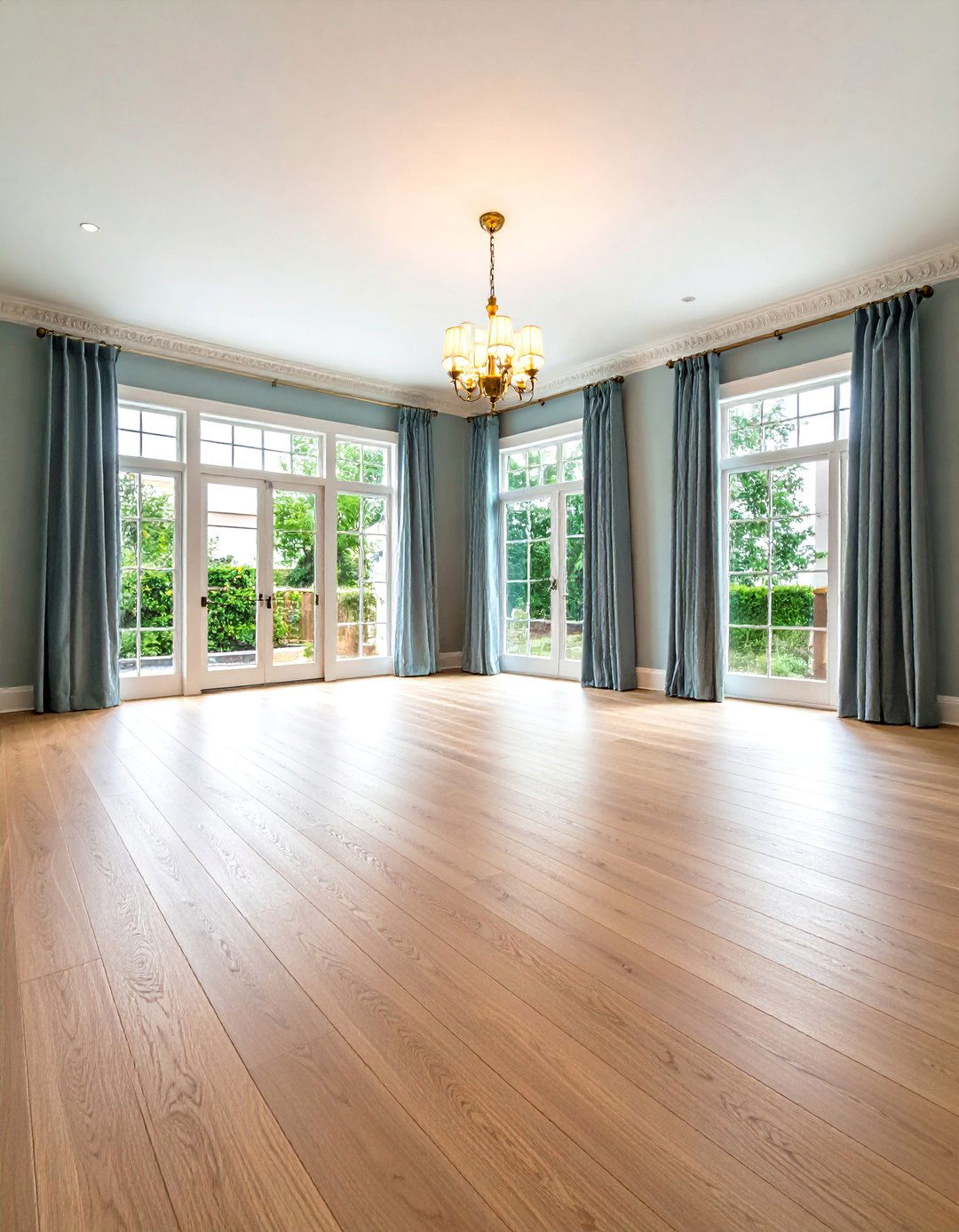
Unlike, solid hardwood, engineered hardwood basement flooring layers real wood over a plywood core, giving timeless elegance plus added stability against humidity swings. Opt for a wire-brushed white oak finish, then complement it with pale linen drapes, recessed LED cans, and brass accents for a boutique-hotel guest suite. A premium underlayment with integrated moisture barrier shields the planks, while discreet baseboard vents maintain airflow. Engineered boards can be sanded lightly once or twice, extending lifespan. Monthly hardwood cleaner and felt pads under furniture preserve the satin sheen. The result is authentic warmth that feels upscale yet attainable.
4. Epoxy-Coated Basement Floor
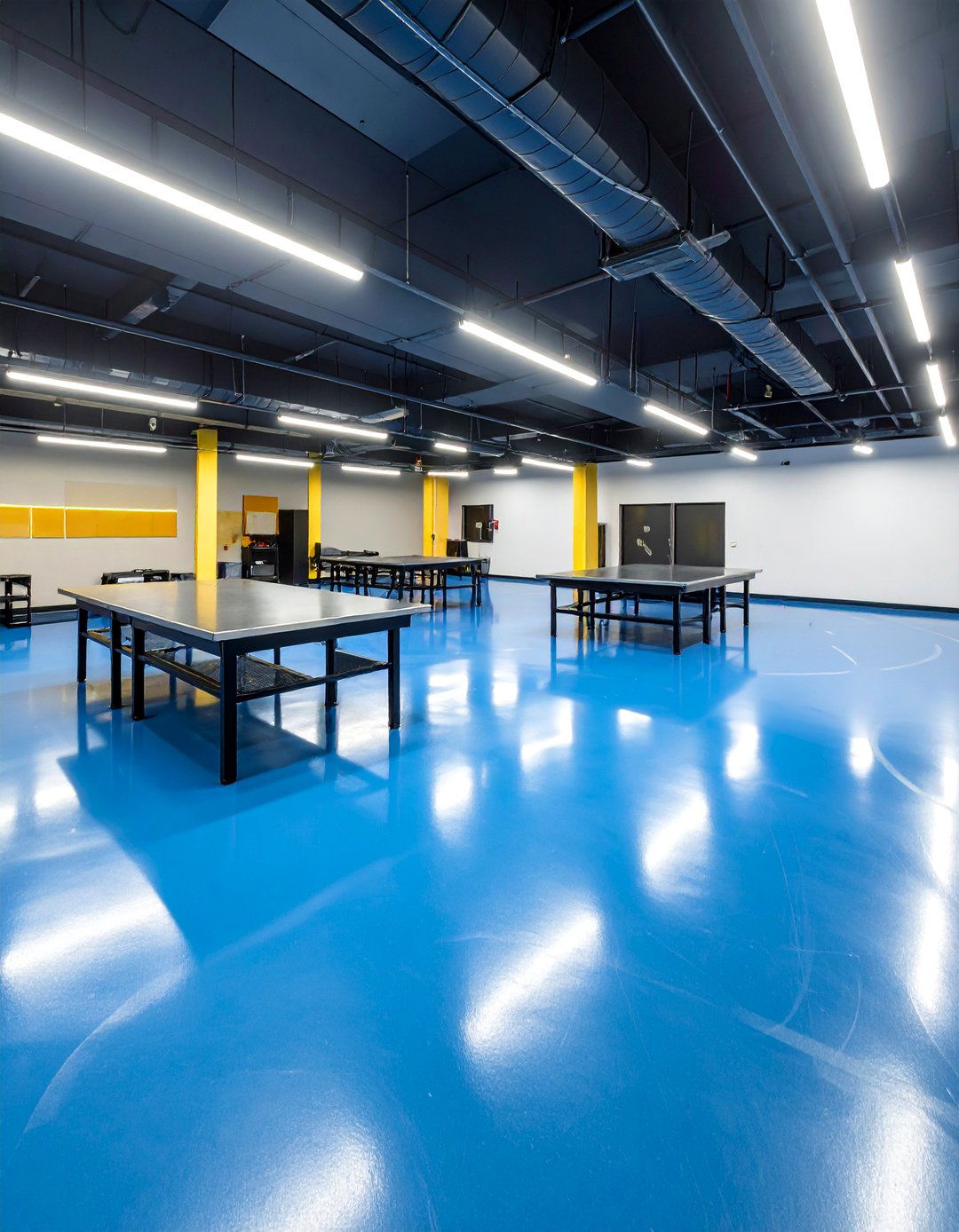
For a workshop that doubles as a game zone, an epoxy-coated basement floor offers industrial strength and customizable flair. By mixing pigments, metallic swirls, or colored flakes into the resin, you can craft anything from a faux-marble surface to a bold team-color statement. Bright-white walls, stainless workbenches, and neon signage complete the energetic vibe. The seamless coating prevents water intrusion, resists chemicals, and wipes clean with mild detergent. Slip-resistant additives ensure safety during DIY projects. Recoat every five to seven years for a refreshed shine, and enjoy a floor that turns the basement into a functional showpiece.
5. Stained Concrete Basement Floor
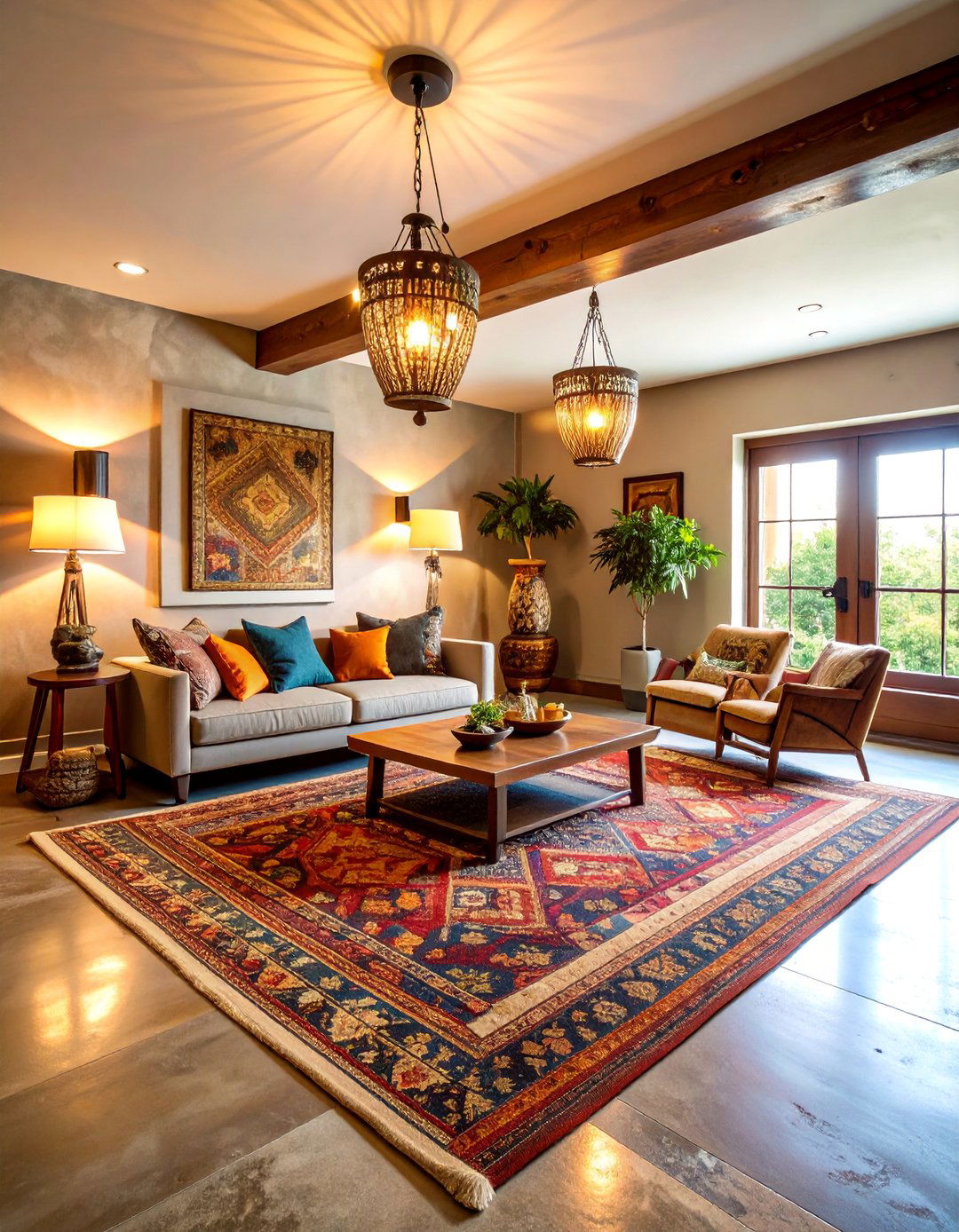
Owing to its earthy depth, a stained concrete basement floor infuses warmth without additional height buildup. Acid or water-based stains create marbled russets, ambers, or verdant tones that complement Southwestern, Mediterranean, or bohemian décor. Add wrought-iron light fixtures, adobe-hued walls, and kilim rugs for a cozy reading retreat. A penetrating sealer locks in color while allowing vapor transmission, critical for below-grade slabs. Dust mop regularly and re-seal every few years to maintain the patina. Because each stain reacts uniquely with concrete minerals, your floor becomes a one-of-a-kind art piece beneath your feet.
6. Porcelain Tile Basement Floor
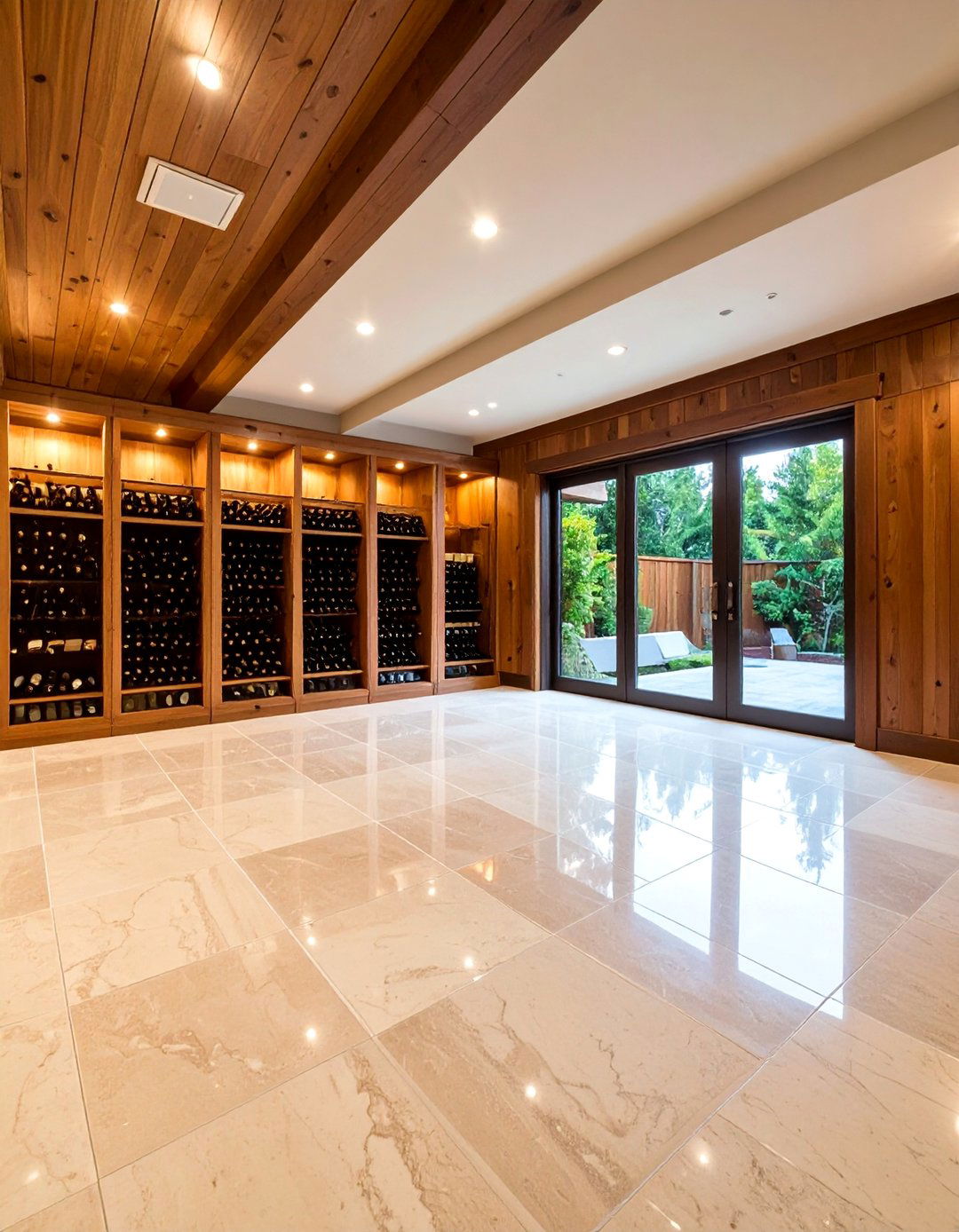
An elegant solution for spa-like bathrooms or wine cellars, porcelain tile basement flooring boasts low porosity and endless design options. Select large-format marble-look tiles, minimal grout lines, and soft under-tile radiant heat for barefoot luxury. Glass-fronted wine racks, cedar paneling, and dimmable sconces enhance the sophisticated mood. Porcelain resists scratches, moisture, and stains better than standard ceramic, while anti-slip finishes offer safety. Install on a crack-isolation membrane to accommodate slab movement. Simple sweeping and pH-neutral cleaner uphold the polished surface. With timeless aesthetics and top-tier durability, porcelain tiles justify their slightly higher cost.
7. Carpet Tile Basement Floor
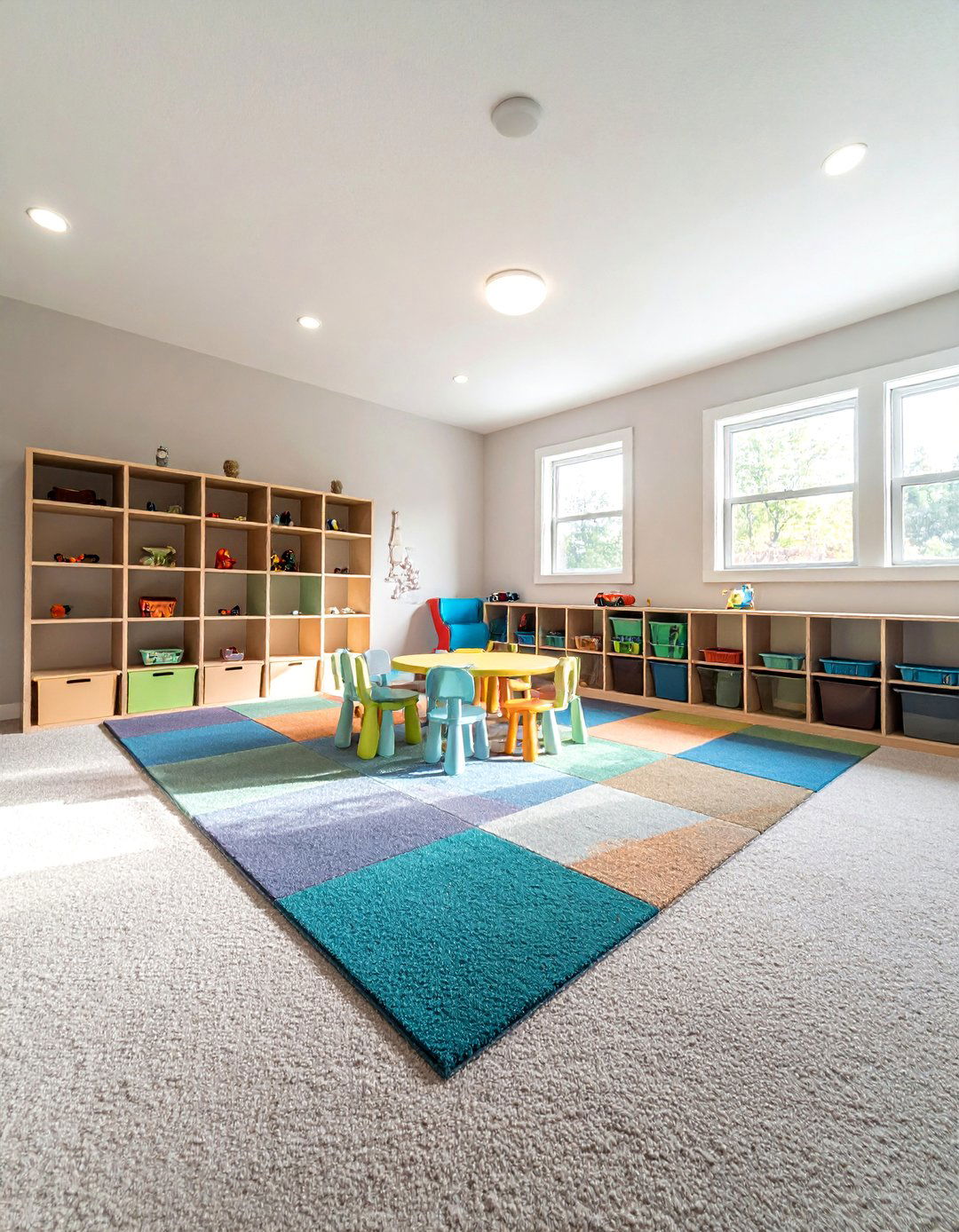
For a family playroom, carpet tile basement flooring delivers softness plus replaceable convenience. Choose colorful modular squares in checkerboard patterns or subtle tweed for a vibrant yet organized look. Pair with pastel walls, built-in cubbies, and cloudlike pendants. Individual tiles peel and stick onto a moisture-proof fiber backing, making DIY installation easy. Should spills or stains occur, swap out a single tile instead of replacing the entire floor. Many brands offer recycled content and low-VOC adhesives, supporting healthier indoor air. Vacuum weekly and spot-clean as needed — the result is cozy comfort even over chilly concrete.
8. Painted Concrete Basement Floor
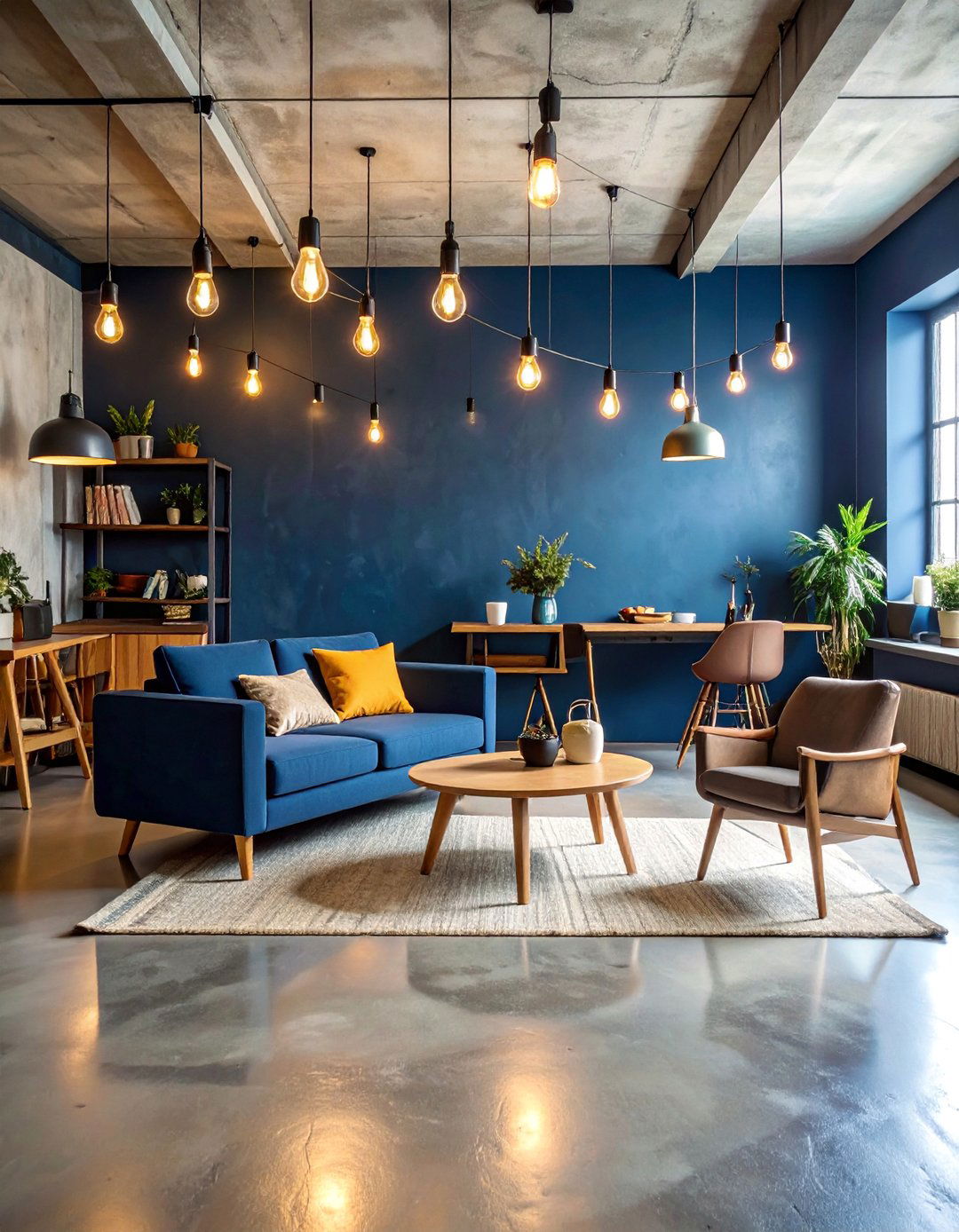
Consider a budget-savvy painted concrete basement floor to refresh a dated space quickly. Start with high-adhesion masonry primer, then roll on epoxy-reinforced floor paint in a soothing greige or bold navy. Stencil a border, stripes, or faux rugs for personality, and add mid-century furnishings, colorful art prints, and string lights for a creative studio. A clear polyurethane topcoat guards against scuffs and moisture. Touch-ups are simple: lightly sand, repaint, reseal. The low material cost and limitless color palette make painted concrete perfect for renters or serial redecorators craving change without demolition.
9. Rubber Gym Basement Floor

To convert your basement into a fitness haven, a rubber gym basement floor provides shock absorption and noise reduction. Interlocking 3/8-inch recycled rubber tiles in speckled black withstand dropped dumbbells while masking dust. Accent the space with mirrored walls, LED strip lights, and ventilated storage cubbies. Rubber’s natural traction keeps cardio routines safe, and its antimicrobial properties resist mildew. Clean by vacuuming crumbs and mopping with a neutral cleaner — no waxing required. The forgiving surface also doubles as a play area for energetic kids, making rubber a versatile, family-centric flooring pick.
10. Cork Basement Floor
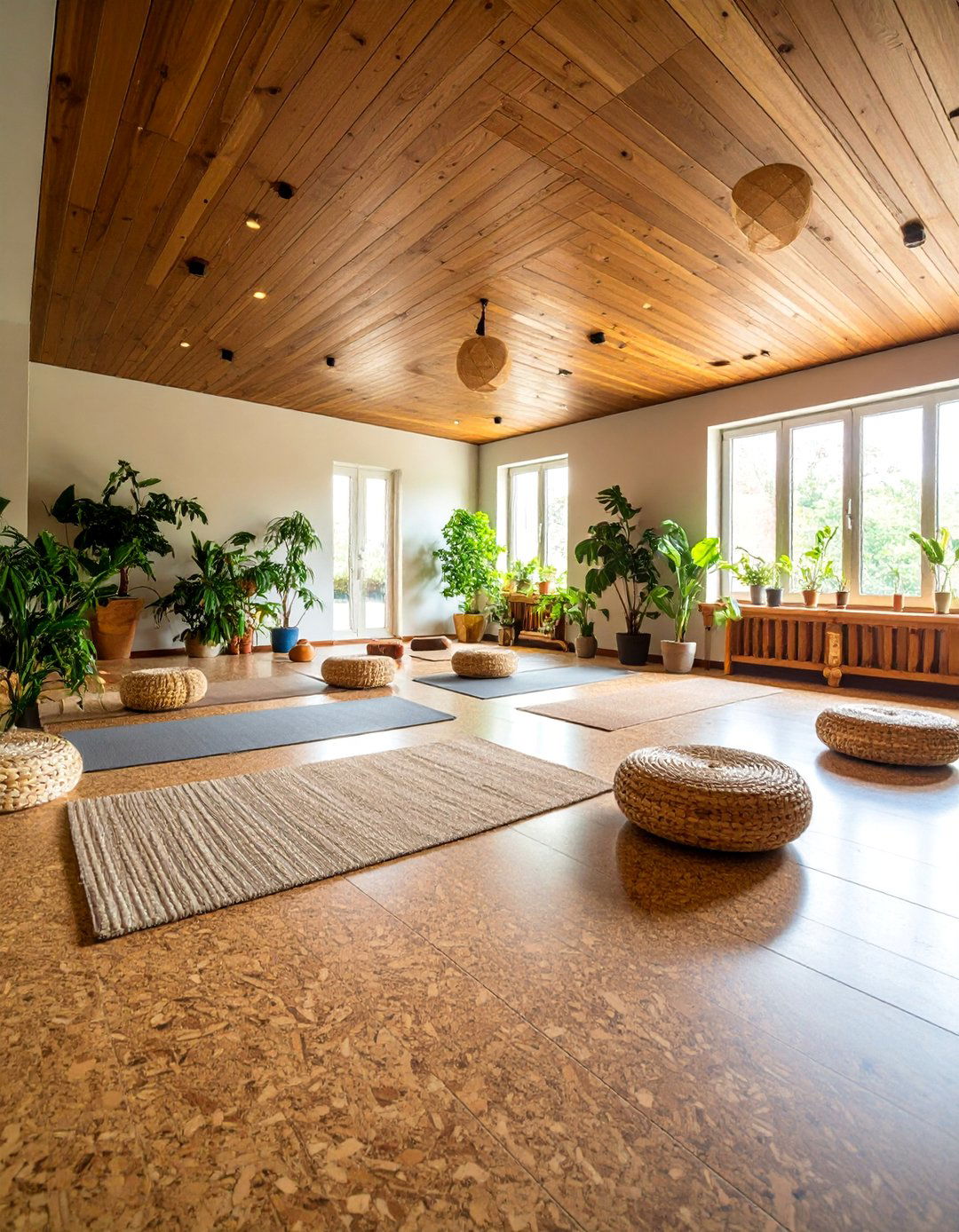
Surprisingly plush underfoot, a cork basement floor suits hobby rooms or yoga studios seeking serenity. Honey-toned planks installed as floating floors radiate warmth both visually and thermally, while cork’s cellular structure absorbs sound and provides subtle give. Pair with sage-green walls, rattan seating, and plenty of houseplants to cultivate a nature-inspired escape. A low-gloss polyurethane finish shields against spills; however, wipe moisture promptly to avoid swelling. Renewable harvesting and hypoallergenic qualities boost cork’s eco-appeal. Refresh the finish every five years and enjoy a calming, barefoot-friendly retreat beneath ground level.
11. Heated Radiant Basement Floor

For unparalleled comfort, a heated radiant basement floor uses electric mats or hydronic tubing beneath tile, concrete, or engineered wood. Imagine stepping onto warm porcelain after a winter shower, surrounded by soft neutral walls, frameless glass, and plush towels — a true spa sanctuary. Programmable thermostats reduce energy waste by warming only occupied zones. Installation over insulation boards minimizes heat loss into the slab. Maintenance is minimal once embedded, and the absence of forced-air vents frees wall space for custom storage. While upfront costs rise, radiant floors turn chilly basements into coveted, cozy living quarters.
12. Reclaimed Wood Basement Floor
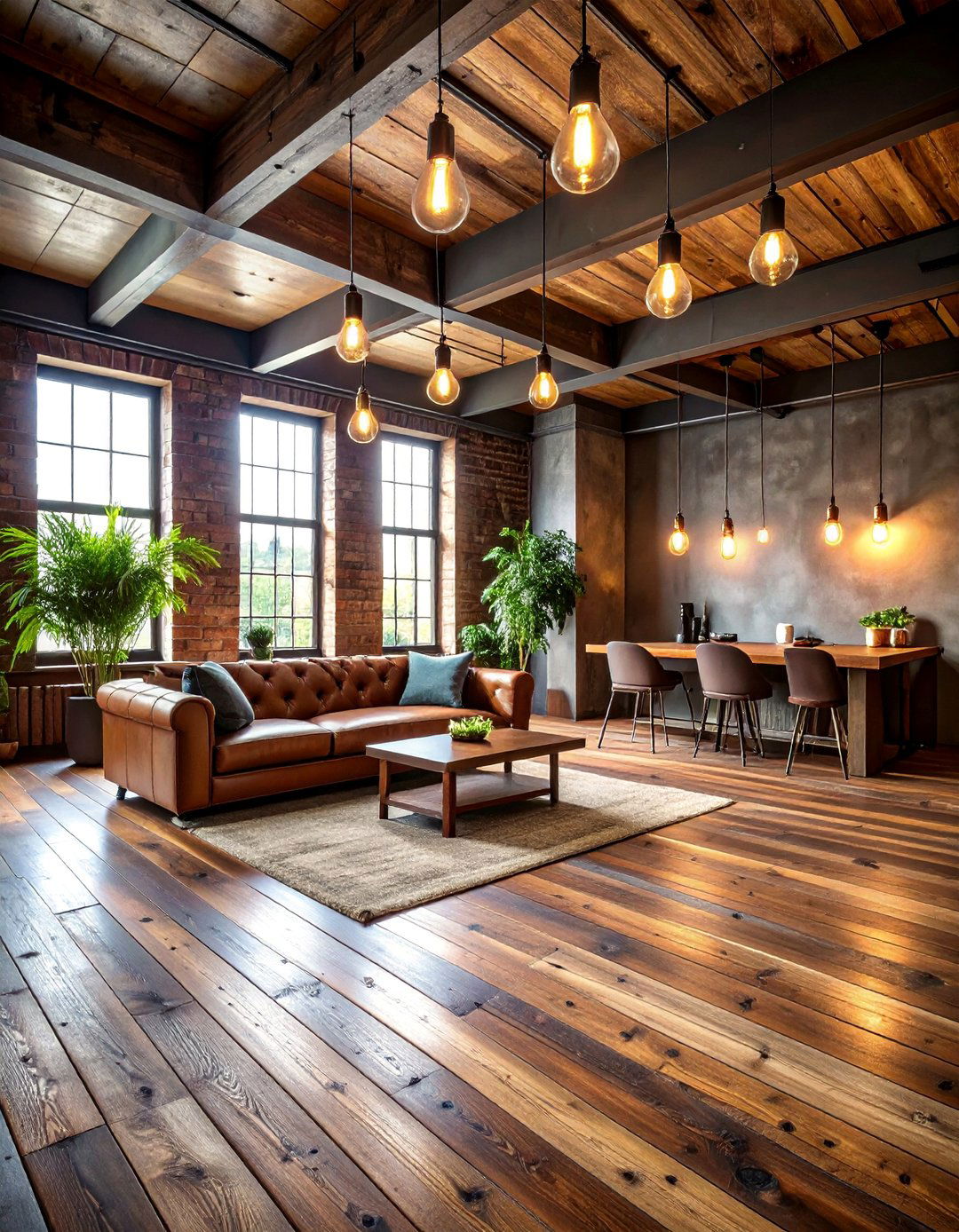
By embracing history, a reclaimed wood basement floor introduces character-rich planks salvaged from barns or factories. Weathered nail holes, saw marks, and varying tones create a rustic storytelling canvas. Complement with vintage Edison bulbs, metal pipe shelving, and leather sofas for an industrial speakeasy vibe. Install a moisture barrier and engineered subfloor panels to protect the aged lumber. Finish with natural oil to enhance grain while allowing the wood to breathe. Routine sweeping and occasional re-oiling preserve authenticity. Environmentally conscious homeowners appreciate diverting materials from landfills and celebrating craftsmanship of bygone eras.
13. Pebble Aggregate Basement Floor
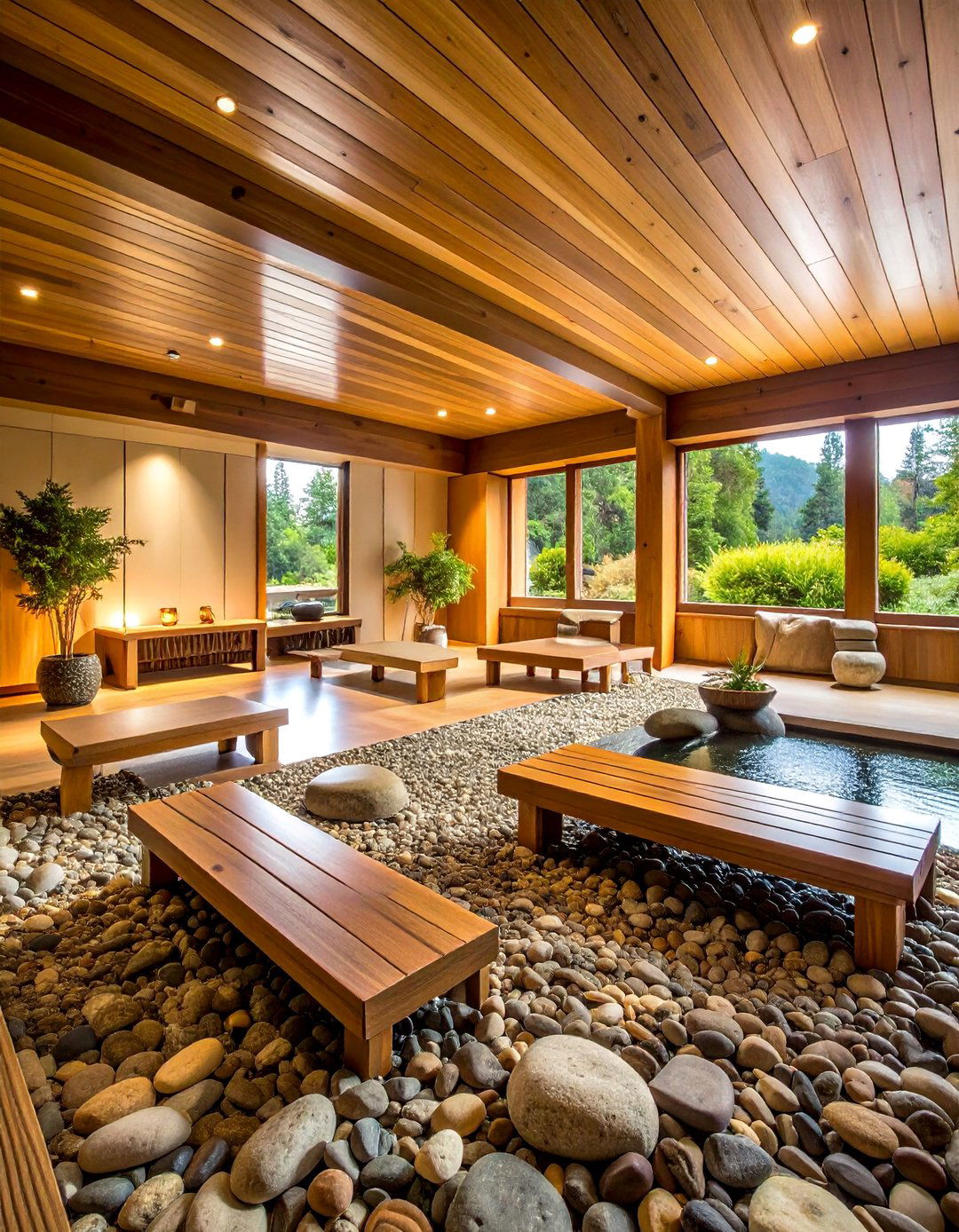
For, an organic, spa-inspired atmosphere, a pebble aggregate basement floor embeds smooth river stones into concrete, then polishes the surface until textures peek through. Soothing water features, cedar benches, and minimalist Zen décor enhance the tranquil mood — ideal for a meditation nook. A penetrating sealer keeps pebbles glossy and impermeable. Despite its artisanal appearance, maintenance involves only vacuuming and damp mopping. Slip-resistant and durable, pebble aggregate floors prove that nature and modern construction can coexist harmoniously beneath your home.
14. Bamboo Basement Floor

As research shows, bamboo basement flooring offers hardwood aesthetics with faster renewable growth. Strand-woven boards boast exceptional hardness, resisting dents from home gyms or children’s toys. Choose caramel-hued planks, install over sound-absorbing underlayment, and finish the space with clean white walls, low-profile furniture, and graphic prints for a Scandinavian look. Bamboo’s dimensional stability fares better against basement humidity than many solid woods, yet a dehumidifier keeps conditions ideal. Non-toxic, water-based finishes streamline cleaning to a simple sweep and damp mop. Eco-friendly and stylish, bamboo bridges sustainability and modern design.
15. Laminate Basement Floor

Unlike pricier options, a laminate basement floor balances affordability with impressive visuals due to high-definition photographic layers. Opt for rustic hickory patterns and pair with shiplap walls, iron light fixtures, and plush sectional seating for a cozy cabin den. The click-together planks float over foam underlayment that both cushions and blocks moisture. Wear layers resist scratches from pets, while beveled edges mimic real boards. Damp-mop sparingly and avoid standing water to extend life. With improved water-resistant cores on the market, laminate remains a smart choice for cost-conscious renovators.
16. Floating Subfloor Basement Floor

To combat cold, damp concrete, a floating subfloor basement system elevates finished flooring on interlocking plastic-backed panels with built-in insulation. Cover the panels with carpet, engineered wood, or vinyl, then dress the room with vibrant art, recessed LEDs, and wall-to-wall bookshelves for a multipurpose study. The raised design creates an air gap, encouraging ventilation and guarding against minor leaks. Installation is DIY-friendly: snap panels in place, lay flooring, add trim. Because the subfloor isolates finished materials from moisture, you’ll prolong their lifespan and enjoy a noticeably warmer surface year-round.
17. Mosaic Tile Basement Floor

Take artistic expression underfoot with a mosaic tile basement floor that turns the space into a gallery. Hand-cut glass, ceramic, or stone pieces form waves, compass roses, or vintage rug motifs — perfect for a wine-tasting lounge or craft studio. Neutral walls and understated furnishings allow the intricate floor to shine. Install over a waterproof membrane and use epoxy grout for stain resistance. While material and labor costs are higher, the payoff is a unique, enduring centerpiece requiring only gentle cleaning. A mosaic floor proves that basements can showcase fine art, not merely hide it.
18. Terrazzo Basement Floor

Certainly, a terrazzo basement floor blends crushed marble, quartz, or glass chips into a cement or epoxy binder, then polishes it into a seamless, speckled expanse. Pair with mid-century furniture, bold color pops, and brass hardware for a retro lounge reminiscent of mod hotels. Terrazzo’s dense surface resists moisture, fire, and allergens, while radiant heat compatibility enhances comfort. A non-yellowing sealer guards shine; routine dry dusting prevents dullness. Though installation is specialized, terrazzo’s 50-plus-year lifespan offsets the investment, delivering glamor and durability in equal measure.
19. Whitewashed Concrete Basement Floor

For light-starved basements, a whitewashed concrete basement floor bounces illumination and evokes coastal calm. After etching and cleaning, roll a translucent white stain, allowing subtle gray tones to peek through. Combine with shiplap ceilings, rattan lounge chairs, and navy accents for a breezy beach retreat. A matte polyurethane topcoat resists scuffs while maintaining the airy aesthetic. Weekly sweeping keeps grit from marking the pale surface. The minimalist palette not only enlarges the visual space but also offers a neutral backdrop for seasonal décor changes.
20. Acid-Etched Concrete Basement Floor

By chemically etching patterns into cured concrete, an acid-etched concrete basement floor achieves intricate, marble-like veining. Imagine swirling sienna and onyx beneath industrial pendants, reclaimed wood tables, and steel staircases for a sophisticated home bar. Neutralize the acid, rinse, then seal with glossy epoxy to deepen colors and protect from spills. The floor’s unique artwork hides minor imperfections and stands up to heavy traffic. Occasional resealing revives the luster. For homeowners craving drama without tiles or planks, acid etching delivers unforgettable style directly in the slab itself.
21. Leather-Look Vinyl Basement Floor
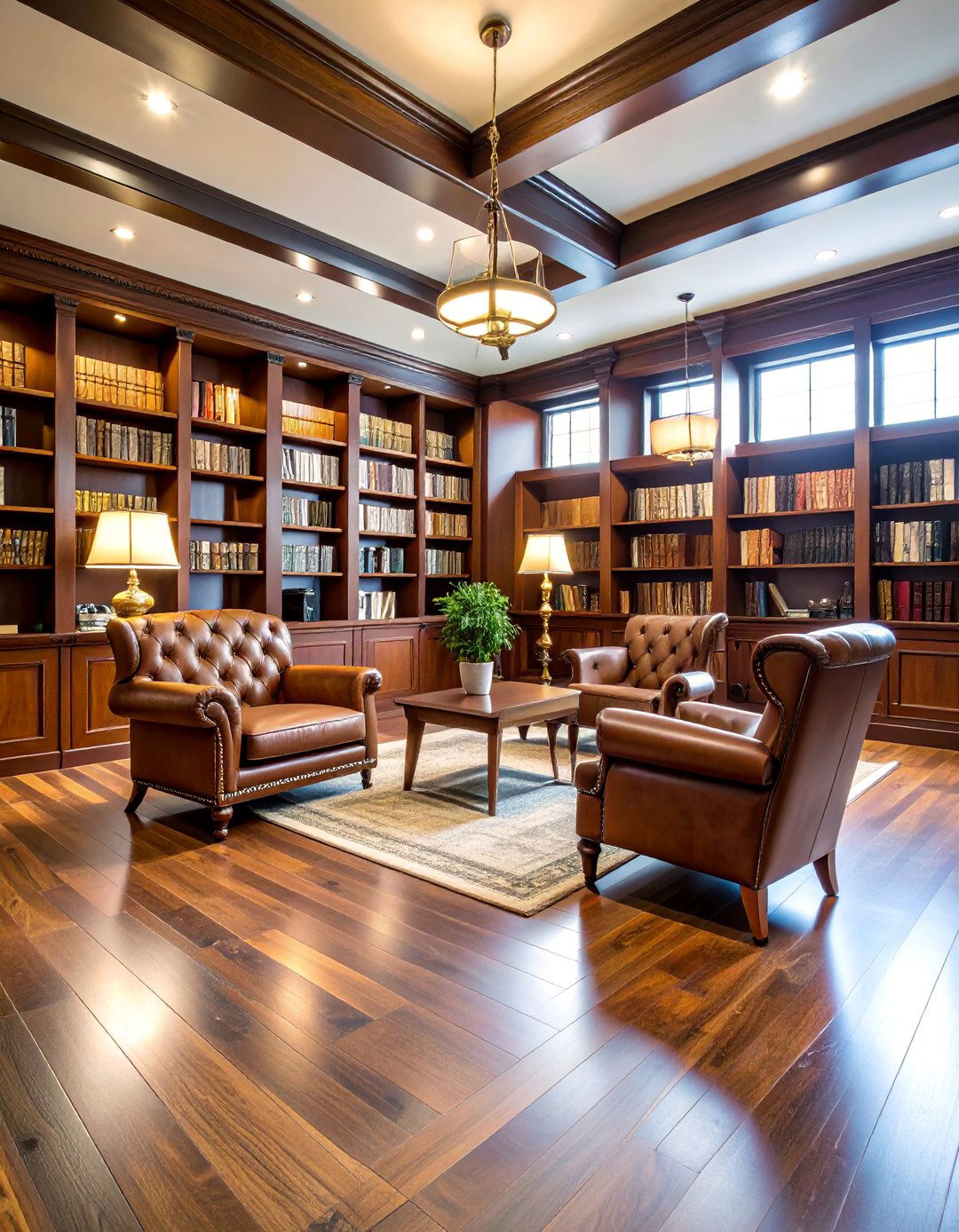
To infuse luxurious warmth, a leather-look vinyl basement floor features oversized tiles textured like suede or saddle hide. Finish the study with mahogany bookshelves, tufted chairs, and brass library lamps for an old-world gentleman’s club vibe. The resilient vinyl resists moisture, stains, and scratches while feeling softer than stone beneath socks. Install as glue-down tiles over a smooth slab and seal seams for waterproofing. Regular sweeping and mild detergent maintain its refined appearance. Your basement gains five-star sophistication without the upkeep of real leather or wood.
22. Sports Court Basement Floor
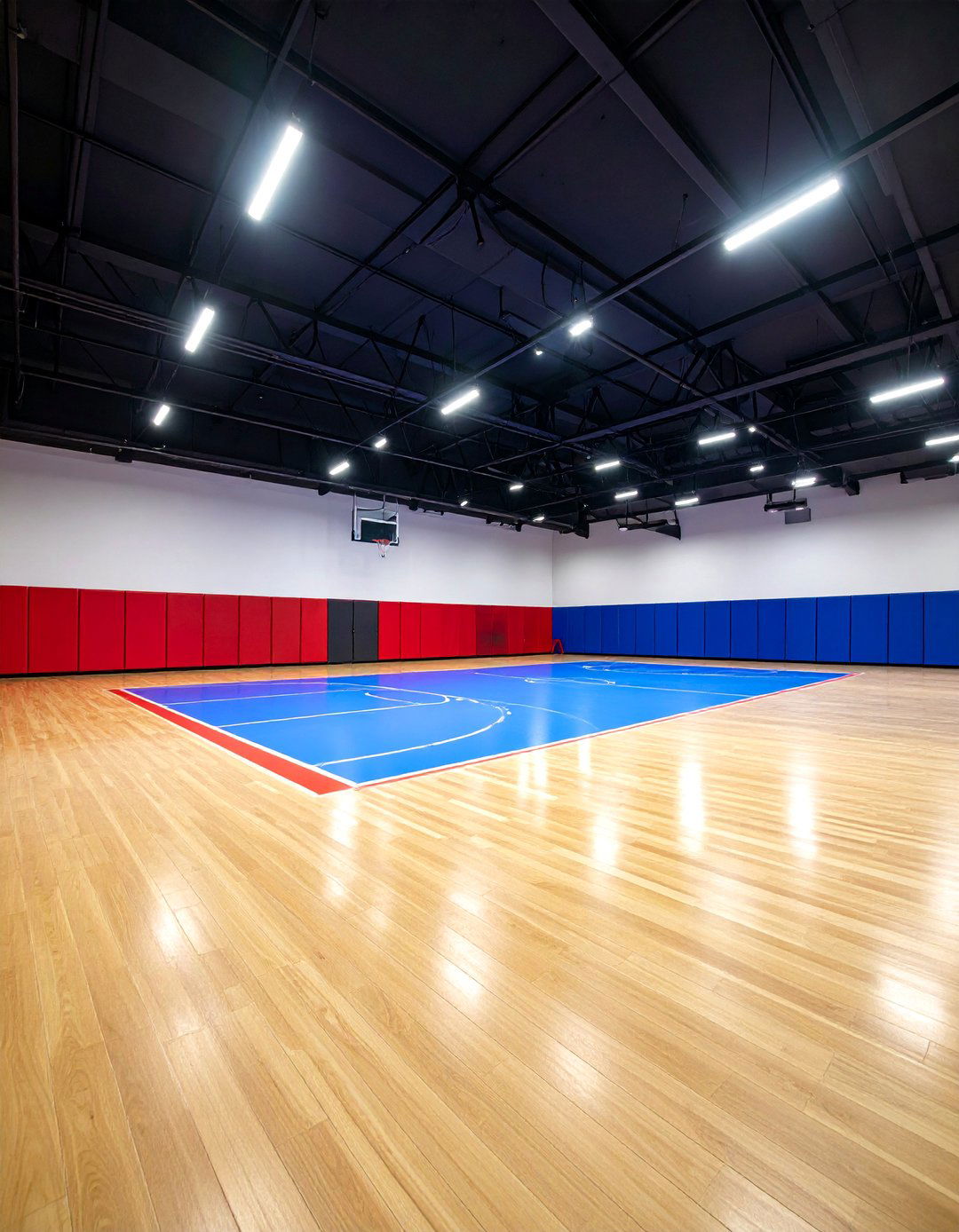
When active families crave year-round play, a sports court basement floor combines shock-absorbing polypropylene tiles marked with basketball or pickleball lines. Bright LED panel lights, wall padding, and built-in ball racks transform the space into a micro-gym. Tiles snap together over a moisture barrier and include sub-surface channels for airflow. Their textured surface offers traction and easy cleaning with a damp mop. Switch tile colors to create team logos or zones for various sports. Durable and fun, a basement court encourages endless healthy activity regardless of weather.
23. Checkerboard Tile Basement Floor
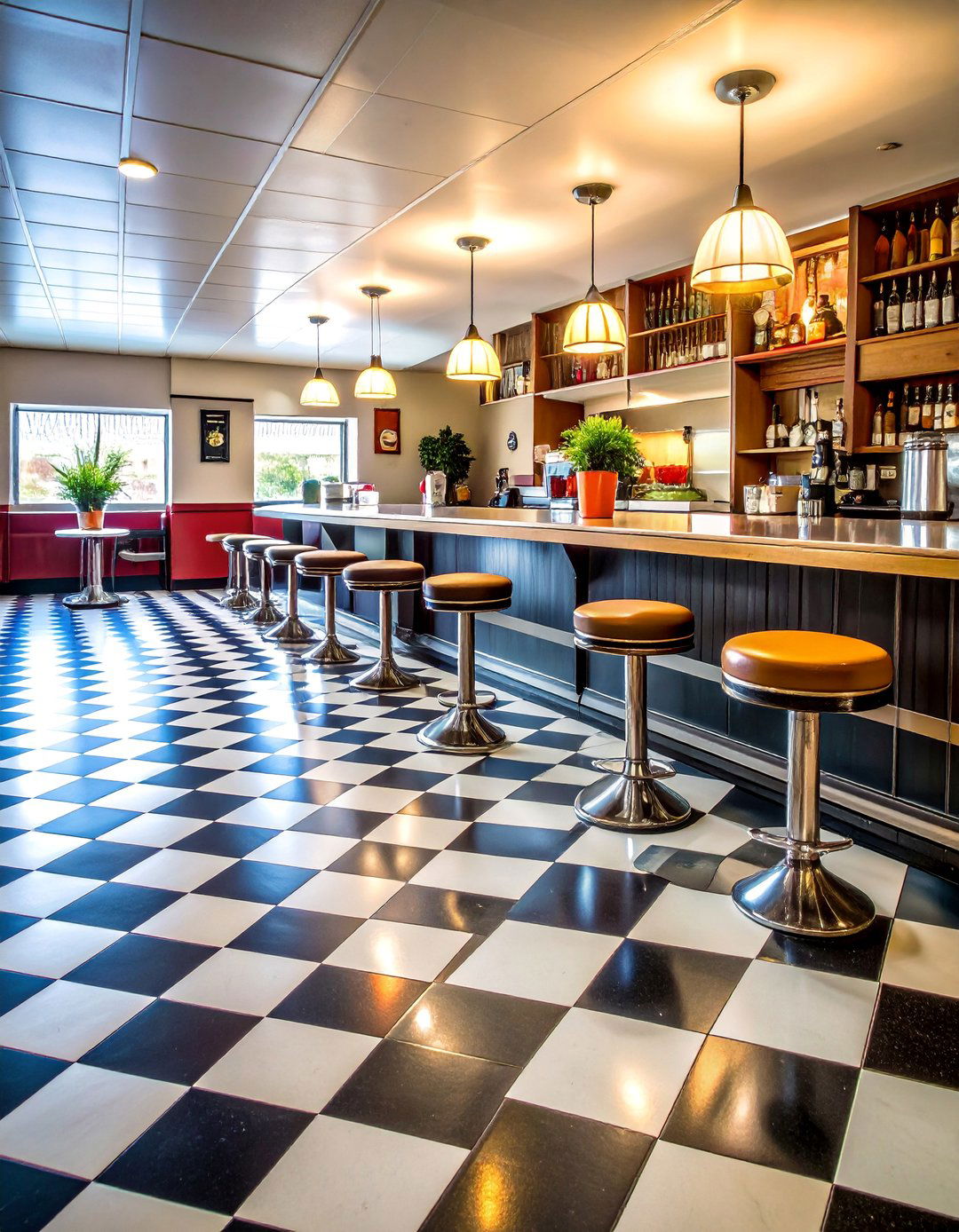
At the, intersection of vintage charm and modern chic, a checkerboard tile basement floor pairs black-and-white porcelain squares laid diagonal for dynamic movement. Complement with crisp wainscoting, chrome barstools, and neon jukebox for a 1950s diner hangout. Choose matte tiles to reduce slipperiness and maintain classic appeal. Install with charcoal grout to hide dirt between cleans. Routine sweeping and occasional mopping keep the graphic pattern striking. A checkerboard floor instantly energizes under-utilized basements with nostalgic style and timeless contrast.
24. Graphic Stenciled Basement Floor
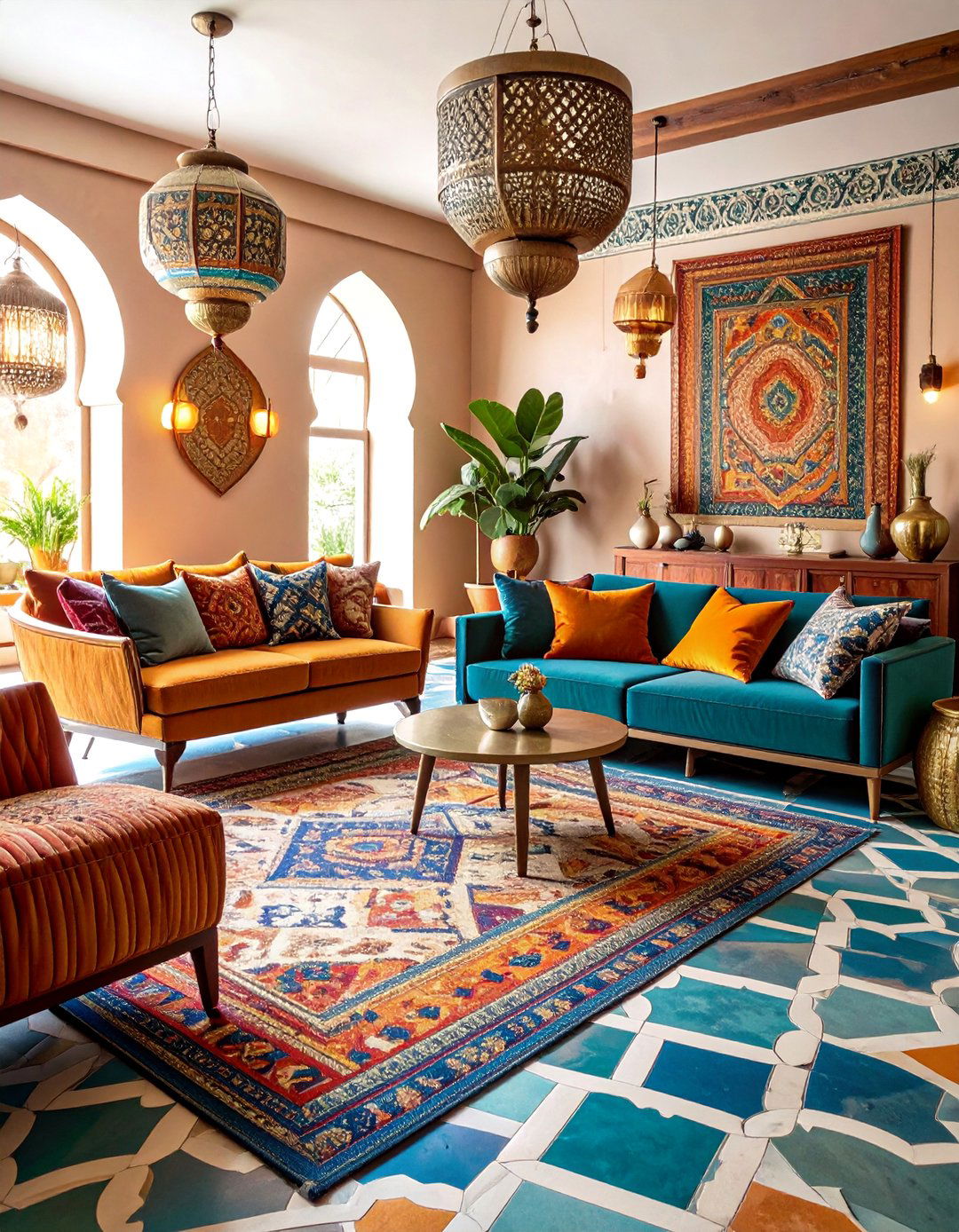
Bringing bold artistry to life, a graphic stenciled basement floor involves layering floor paint through oversized stencils — think Moroccan quatrefoils or Art Deco fans — onto sealed concrete. Add velvet sofas, metallic side tables, and eclectic gallery walls for a boho-glam lounge. Use contrasting yet cohesive colors for depth, then topcoat with water-based polyurethane. Touch-ups are straightforward: simply re-stencil affected areas. The DIY approach keeps costs low while delivering huge impact, proving that statement flooring doesn’t require pricey materials.
25. Sustainable Recycled Rubber Basement Floor
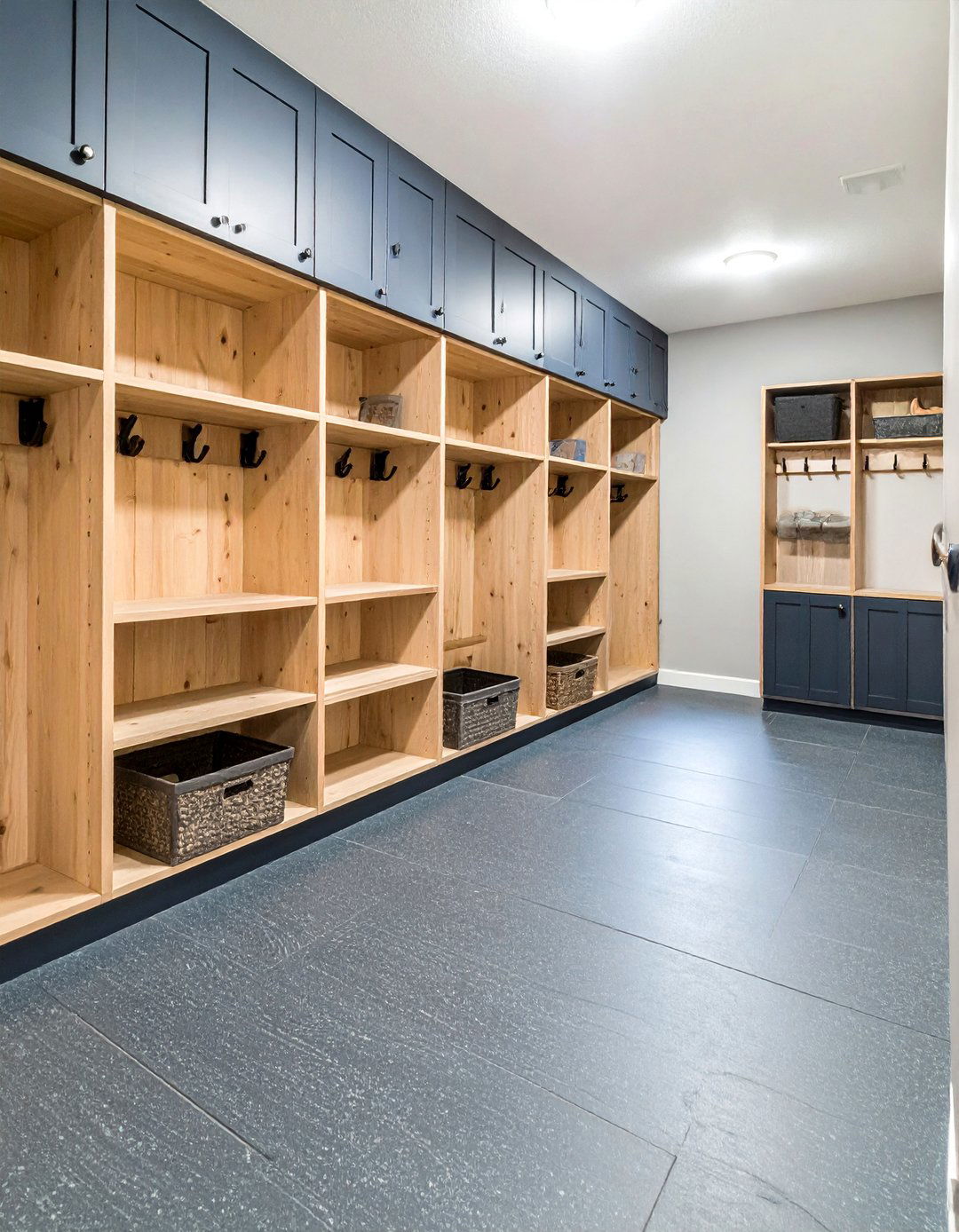
Finally, a sustainable recycled rubber basement floor turns discarded tires into stylish utility. Speckled slate-gray rolls create a seamless surface ideal for mudrooms or pet zones, paired with cedar storage cubbies and galvanized wall hooks. The non-porous rubber repels water, dampens noise, and provides thermal insulation. Low-VOC manufacturing supports green building goals, while simple soap-and-water cleaning speeds chores. Because color flecks hide scuffs, the floor stays fresh despite heavy use. By choosing recycled rubber, homeowners prioritize planet-friendly living without sacrificing practicality or aesthetics.
Conclusion:
Basement flooring can be so much more than plain concrete. From polished slabs and luxury vinyl to mosaics and recycled rubber, each idea above marries moisture resistance with distinctive style. Pick the concept that aligns with your basement’s purpose, climate, and design vision, and you’ll create a space that feels inviting, durable, and uniquely yours — starting from the floor up.





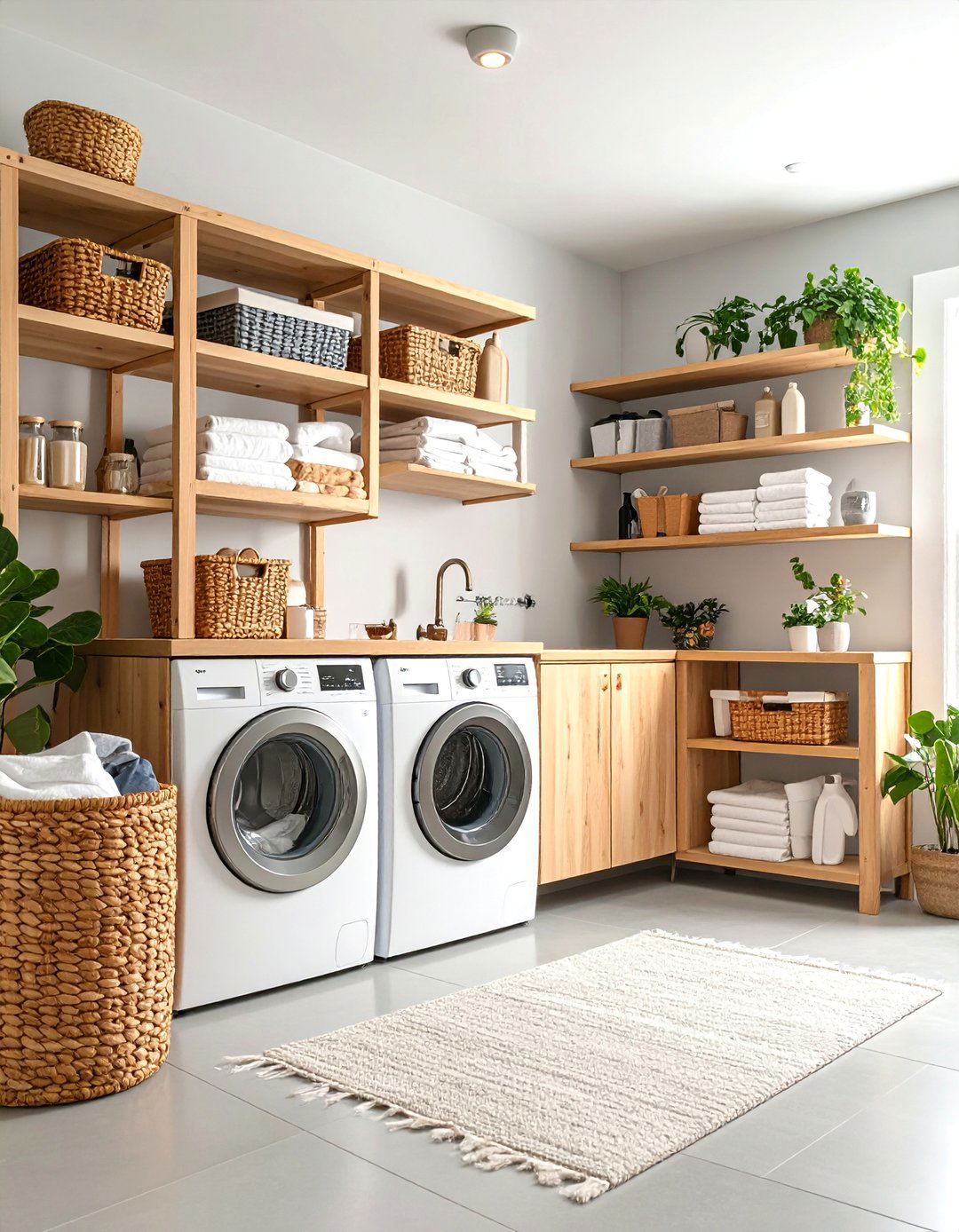

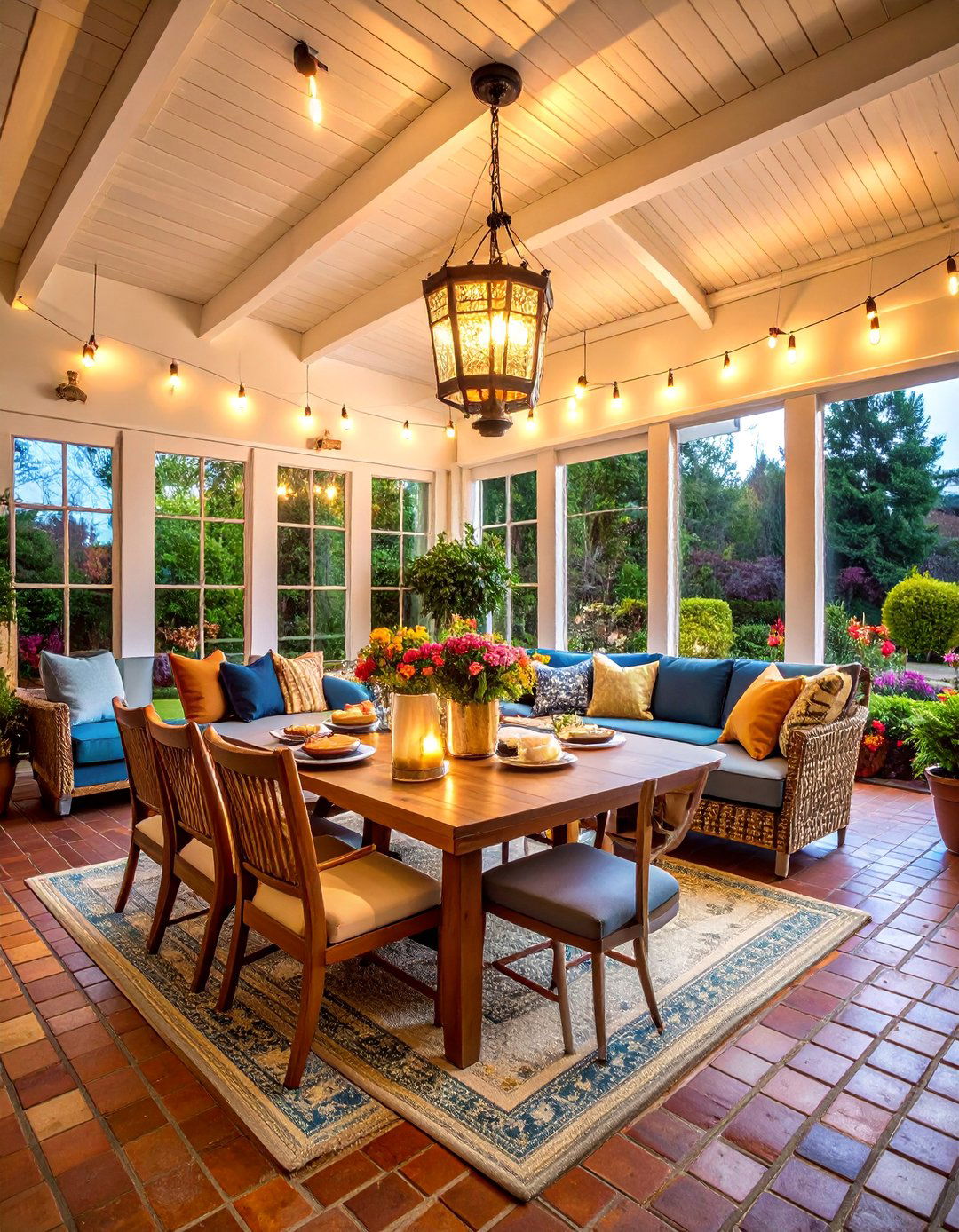
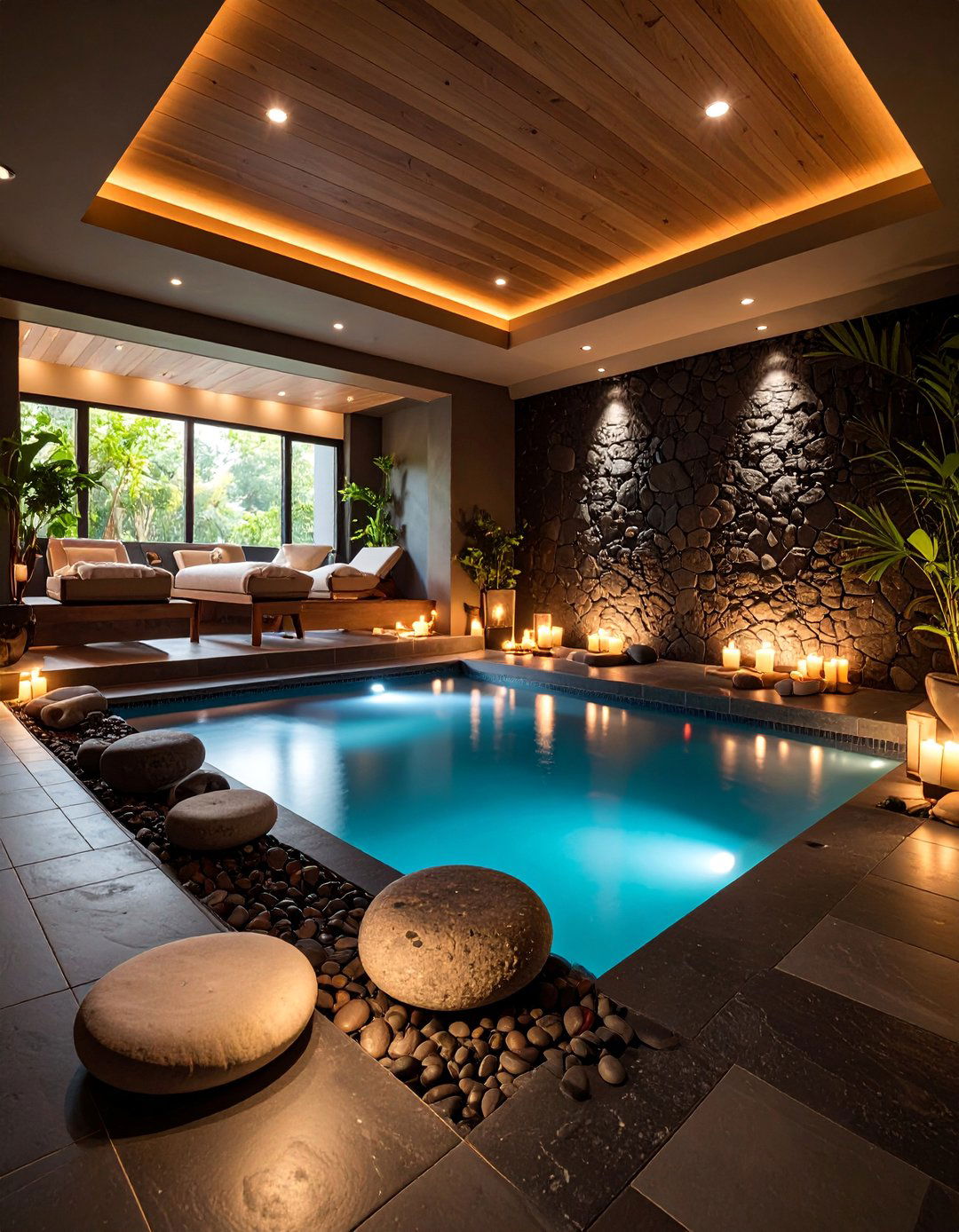


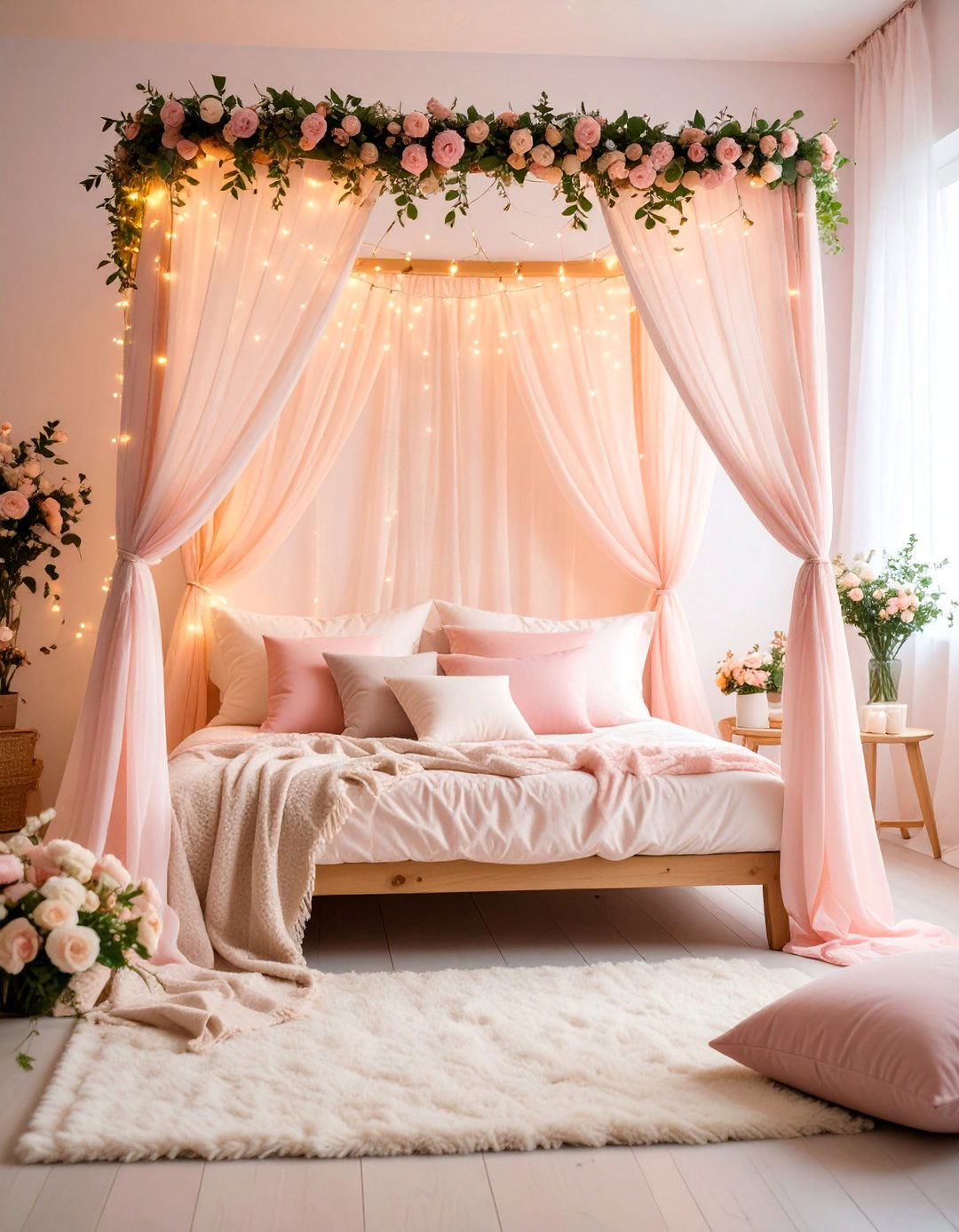

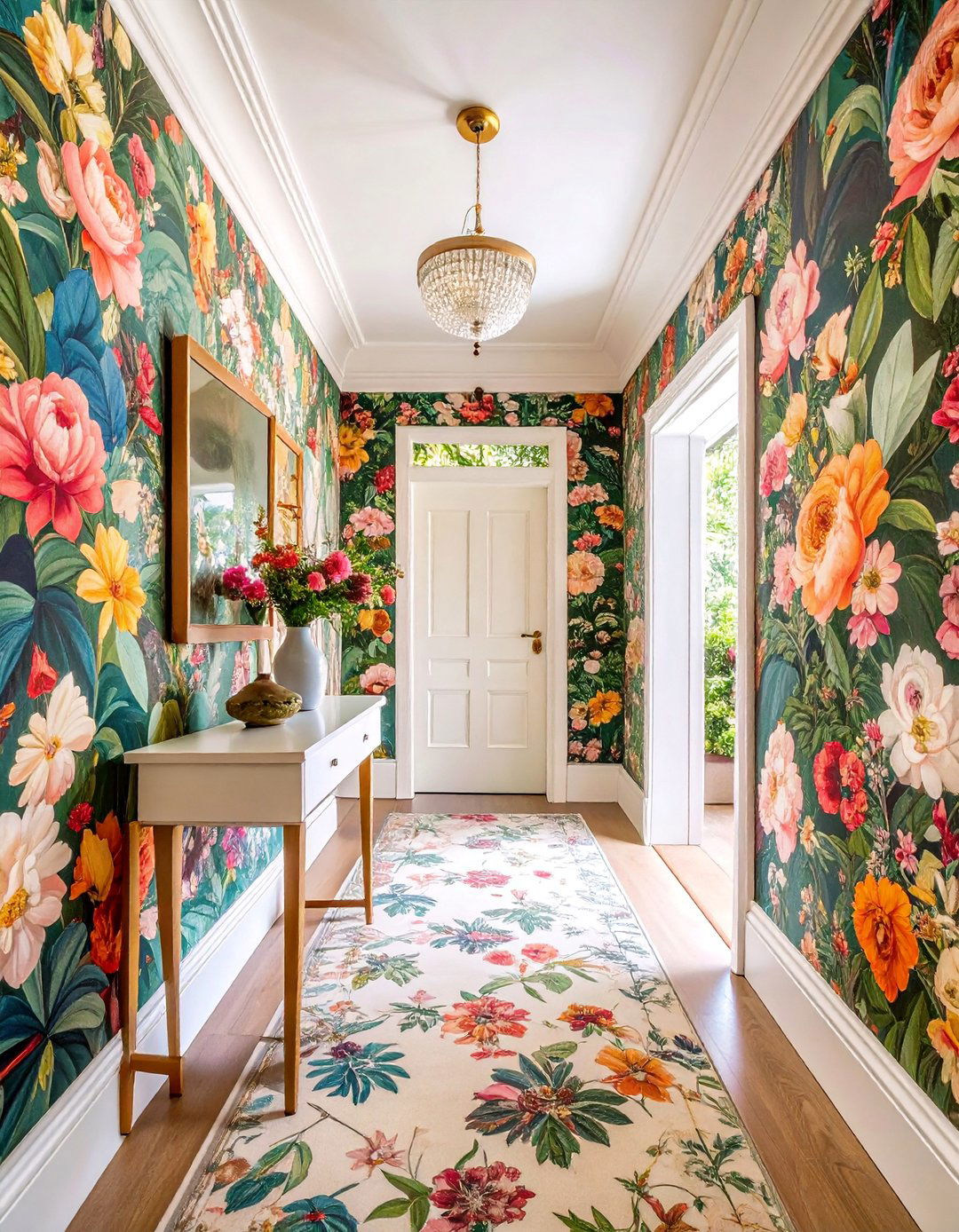

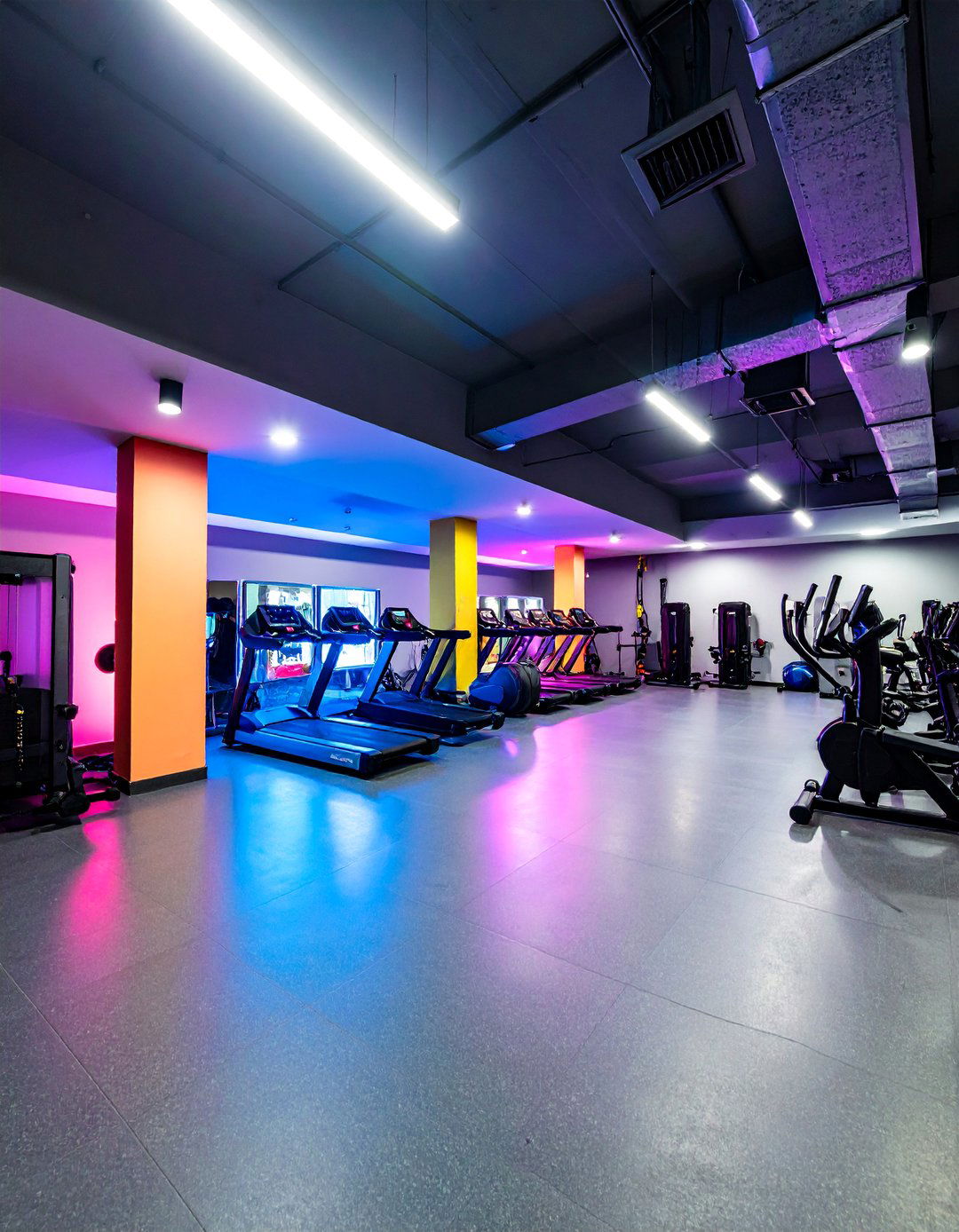
Leave a Reply